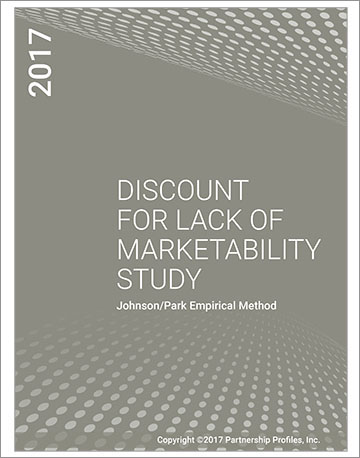2017 Discount for Lack of Marketability Study
July 2017 PDF
Bruce A. Johnson, James R. Park
Johnson/Park
The 2017 Discount for Lack of Marketability Study provides objective rate of return measures to implement the Johnson/Park Empirical Method for determining a discount for lack of marketability (DLOM) for the valuation of interests in privately held corporations and partnerships. This report instantly provides you with the most current DLOM rate of return information including a thorough explanation and example on how to apply this data. This methodology has been used in several tax court cases including the first family limited partnership (FLP) case to go to trial.
Practitioners often apply a fixed discount for lack of marketability without regard to the resulting effect on the rate of return. This practice is inconsistent with the fundamental concept of valuation which compares risk to reward. To determine the size of the discount, the three rate of return studies in this report can be used to measure the increase in return required to compensate investors for the lack of marketability of your subject interest. Based on the BVR DLOM Survey, the Johnson/Park Empirical Method is the third most popular method used to determine DLOMs by BV appraisers. Order today and receive the complete report to support your DLOM analysis.
“When determining the appropriate amount by which the interest should be discounted for lack of marketability, the effective increase in return should be sufficient to compensate an investor for illiquidity and the additional risks associated with ownership of a privately held interest.”
—From the pages of the Discount for Lack of Marketability Study
Table of Contents
- Explanation of Relationship Between DLOM and Rates of Return
- Introduction to Three Studies Supporting Increase in Rate of Return
- Study 1 - Private Equity vs. Public Equity Returns
- Study 2 - Restricted Stock Returns
- Study 3 - Long Term vs. Short Term Bond Horizons
- Summary of Results
- Application/Example
- Conclusion
